Raised Bed Gardens
How to lay out and build raised beds for growing delicious vegetables at home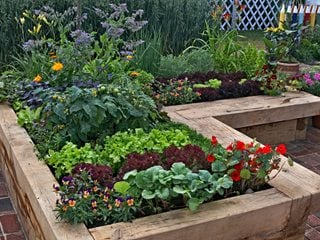
Photo by: Gardens by Design / Shutterstock.
Raised bed gardens are one of the most productive ways to grow your own food. They give you better control over the soil conditions and allow for quick and easy harvesting of your crops. Raised beds can be simple or quite elaborate depending on your needs and the overall aesthetic you wish to create. Use the information below to determine what type of raised beds you would like in your own garden.
HOW TO BUILD A RAISED BED
Building raised beds is an excellent DIY project for those wanting to grow their own food. You’ll just need a few tools and some hard workers. See a step-by-step slideshow of one of our columnists creating a raised bed garden.
Pick the perfect spot
- Full sun is an absolute must for growing vegetables.
- Level ground will make installation a breeze.
- Tuck veggie beds away so they don't detract from the rest of your garden when out of season.
Choose the material for your raised bed
- Untreated rot-resistant wood is the most popular choice.
- Avoid railroad ties because they are treated with creosote, which will leak toxins into the soil.
- Here are some of our favorite options:
Determine bed size and layout
- Don’t make your beds wider than 4 feet, this way you can easily reach to the center.
- The ideal depth is between 12 and 24 inches.
- Leave at least an 18-inch path between beds, more if you want wheelbarrow access.
Build your raised beds
- Wooden beds can be easily secured together at the corners with galvanized screws (corner posts are optional) or use planter wall blocks for the corners and joints.
- Stone or block beds can be installed with or without mortar.
- Want instant gratification? Try galvanized stock tanks or prefab raised beds that go together in no time.
Line the bottom of your beds
- Corrugated cardboard or newspaper will prevent weeds or grass from growing up through your raised bed.
Fill your raised beds with soil
- A great soil recipe for raised beds is 1 part top soil, 1 part composted manure and 1 part sand.
- Bagged soils can also be used.
Plant your veggies
- Digging will be easy in the soft dirt and your back will thank you come harvest time.
- If you have more than one bed, rotate your crops each year.
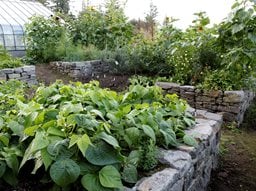 Photo by: Susan Seubert. |
Stacked Stone.These raised beds, shown at the height of the growing season, are made from stacked stone. Some gardeners prefer stone to wood for their beds because there is less maintenance. Others chose stone because they love the way it looks. The only downside is that the upfront investment is typically more with stone. |
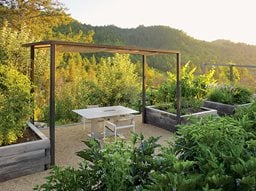 Photo by: Marion Brenner. |
Recycled Redwood.These eco-conscious raised beds hold eggplant, squash, tomato, and herb plants. Redwood is a good choice for planters like these because it is more resistant to rot than most types of wood. In fact, this wood has held up so well that it has found a second life in this application. A small shaded table provides an idyllic spot to sample produce at its freshest-straight from the garden. |
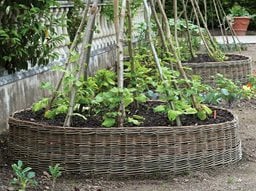 Photo by: Tim Gainey/Gap Photos LTD. |
Woven Wattle.Nothing is ordinary about these raised beds. First, they veer from the norm with their circular shape. Second, they are made of twigs woven together in a basket-like fashion. To complete the look, handmade tepee trellises add vertical support for climbers. |
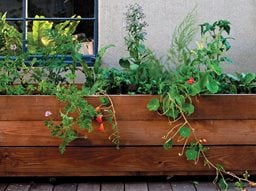 Photo by: Gemma & Andrew Ingalls. |
Redwood Box.If you’d like to grow veggies on your deck or patio, try a redwood planter box like this one. Much like raised beds, self-contained planters, offer better soil control and easier harvesting, plus they can be moved around if necessary. |
HOW DO YOU WATER RAISED BEDS?
The best way to know when it is time to water is to feel the soil. You want it to feel slightly moist, like a towel that’s been wrung out. Vegetables don’t like their soil to be too dry or too wet, so find the right balance. You’ll have more success watering in the morning so that the soil has all day to dry out.
Hand watering.
Although it can be time-consuming, many gardeners prefer to water their raised beds by hand because they like being in the garden and use this time to check in on their plants. In fact, you may even find the process therapeutic! Some people prefer using a watering can because they don’t have to worry about hose problems, such as kinks, and plant damage. However, watering cans can be heavy and you may have to make many trips back to your water source. A watering wand attached to a hose is a nice alternative that will speed you up and easily get water to all the plants in your beds.
Automatic irrigation.
For those that don’t have the time to water their raised beds daily, soaker hoses or drip irrigation are good options. Soaker hoses, which slowly seep water into the soil, can be laid throughout your beds to provide consistent water to all your vegetables. Drip irrigation features small emitters that deliver water at the perfect rate directly to each plant’s root zone. Both options can be set up to run on a timer so you don’t have to lift a finger. Check out this video from Laura at Garden Answer: How to Install a Drip System in Raised Beds.
Also, see Irrigation for Your Garden for more on garden watering.
Related Reading
 Growing Potatoes in Raised BedsLearn how to plant and grow a bountiful potato harvest in raised beds.
Growing Potatoes in Raised BedsLearn how to plant and grow a bountiful potato harvest in raised beds.  A Guide to Growing PeppersTips for choosing, planting, and growing the right peppers for your garden and taste.
A Guide to Growing PeppersTips for choosing, planting, and growing the right peppers for your garden and taste. 
